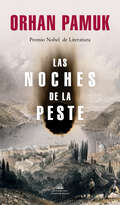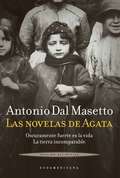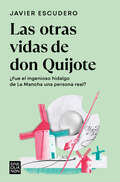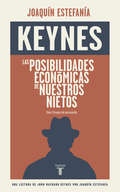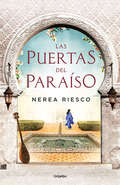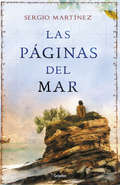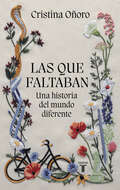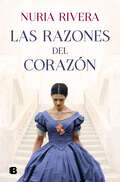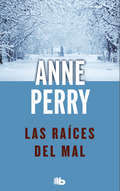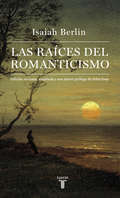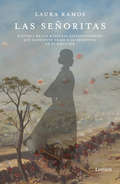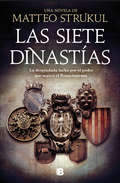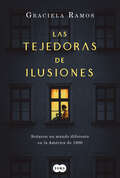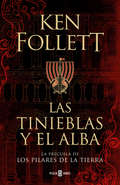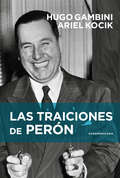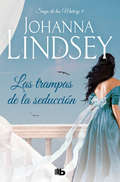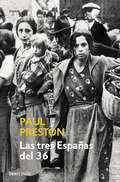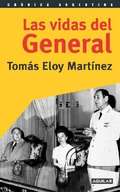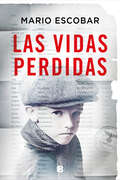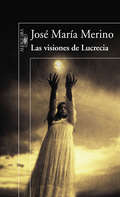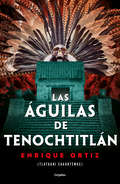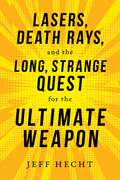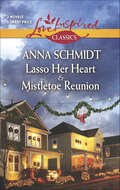- Table View
- List View
Las noches de la peste
by Orhan PamukLA NUEVA NOVELA DEL PREMIO NOBEL DE LITERATURA AMOR, INTRIGA Y LUCHA EN UNA HISTORIA SOBRE LAS PANDEMIAS Y LAS REVOLUCIONES DEL PASADO Abril de 1901. Un barco se dirige hacia la isla de Minguer, la perla del Mediterráneo oriental. A bordo se encuentran la princesa Pakize Sultan, sobrina del sultán Abdülhamit II, y su reciente esposo, el doctor Nuri, pero también un misterioso pasajero que viaja de incógnito: el célebre inspector jefe de sanidad del Imperio otomano, encargado de confirmar los rumores de peste que han llegado hasta el continente. En las animadas calles de la capital portuaria nadie puede imaginar la amenaza, ni la revolución que está a punto de fraguarse. Desde nuestros días, una historiadora nos invita a asomarnos a los meses más turbadores que cambiaron el rumbo histórico de esta isla otomana, marcada por el frágil equilibrio entre cristianos y musulmanes, en un relato que combina historia, literatura y leyenda. En esta nueva obra del Nobel, destinada a convertirse en uno de los grandes clásicos sobre plagas, Pamuk indaga en las pandemias del pasado. Las noches de la peste es la historia de supervivencia y lucha de unos protagonistas que lidian con las prohibiciones de la cuarentena y la inestabilidad política: un apasionante relato épico de atmósfera asfixiante donde la insurrección y el asesinato conviven con las ansias de libertad, el amor y los actos heroicos. La crítica ha dicho: «Las noches de la peste [...] está llamado a convertirse en uno de los grandes clásicos de la literatura sobre las narrativas del pasado y hasta el origen de las revoluciones y de los Estados nación». Inés Martín Rodrigo, ABC «Promueve la idea de que siempre debemos interrogar al pasado, pero nunca negarlo o enterrarlo»Financial Times Sobre el autor y su anterior obra se ha dicho: «Borges, Eco o Italo Calvino son el punto de referencia de este autor que bebe de las aguas hipnóticas y duales de una ciudad permanentemente escorada entre dos orillas, Oriente y Occidente.»ABC Cultura «La obra de Pamuk es un mosaico complejo que le ha valido para ser una de las voces más autorizadas en el panorama narrativo internacional.»El País Semanal «[Orhan Pamuk] se ha ganado el derecho a ser comparado con Jorge Luis Borges e Italo Calvino, quienes presiden esta novela como ángeles de la guarda... Un narrador con tanto coraje y chispa narrativa como Scheherazade.»The New York Times Book Review Sobre Estambul se dijo: «Estambul es un libro escrito por un hombre enamorado de su ciudad.»Alberto Manguel Sobre Una sensación extraña se dijo: «Pamuk nos guía por un relato que, recorriendo varias décadas de pérdida, es, a su vez, un retrato casi antropológico de la obsesión, la clase social y las ideas sobre Oriente y Occidente.»The New York Times «Pamuk reveló un gran talento narrativo desde el primer momento y su visión de Turquía, lejos de estereotipos, nos muestra la esencia de un país que ha forjado su identidad combinando tradición y modernidad.»El Cultural Sobre La mujer del pelo rojo se dijo: «Una emotiva historia de amor, una ambiciosa caja de resonancia de mitos milenarios y un perspicaz retrato de Turquía, con sus vicios y sus virtudes.»Rafael Narbona, El Cultural de El Mundo «Promueve la creencia de que siempre debemos interrogar al pasado, pero nunca negarlo o enterrarlo.»Financial Times
Las novelas de Agata: Oscuramente fuerte es la vida. La tierra incomparable
by Antonio Dal MasettoEsta edición definitiva reúne dos novelas emblemáticas de la narrativarealista que abordan temas esenciales de la literatura argentina. En Oscuramente fuerte es la vida la protagonista, Ágata, una mujernacida en 1911, relata los hechos y los sueños de su vida, larga afuerza de empecinamiento y coraje, y acarrea consigo el destino demuchos inmigrantes, quienes identifican esa voz como propia. Cuarentaaños después de su llegada a la Argentina, Ágata, ya anciana, decideregresar a su tierra natal en Italia y así es como «La tierraincomparable» narra ese viaje nostálgico de recuperación. Prodigio deintensidad y concisión, de rigor y sutileza perceptiva, este libroretoma temas esenciales de la literatura argentina, con el selloimborrable de Antonio Dal Masetto.
Las otras vidas de don Quijote: ¿Fue el ingenioso hidalgo de La Mancha una persona real?
by Javier EscuderoEl ensayo rompedor que nos muestra el auténtico origen de la figura más emblemática de la literatura española. Don Quijote de la Mancha es uno de los personajes más célebres de la historia de la literatura. Desde que se presentó por primera vez al público hace más de cuatrocientos años, ha cabalgado y protagonizado novelas profanas, ensayos, obras teatrales, películas y todo tipo de homenajes. Gracias a ello, sus aventuras y su locura se han convertido con el tiempo en símbolos del triunfo de la imaginación. Pero ¿y si no todo ello fuera imaginado? Javier Escudero lleva más de veinte años dedicados a la investigación de la obra de Cervantes y a los documentos públicos y privados de su época. Gracias a ello, ha podido descubrir que hubo otros hidalgos de «lanza en astillero, adarga antigua, rocín flaco y galgo corredor» y que incluso alguno de ellos se enfrentó a los molinos de viento. En este libro, nos adentramos en esa Mancha de la que no queremos acordarnos y que poco tiene de inventada para dar respuesta a la pregunta: ¿quién fue realmente don Quijote?
Las posibilidades económicas de nuestros nietos
by John Maynard KeynesPor primera vez, la obra de John Maynard Keynes, el economista más influyente del siglo XX, puesta a disposición del gran público. Sin duda hoy la mayoría de los ciudadanos cree en el poder de los gobiernos y de las intervenciones públicas a la hora de evitar las depresiones, el desempleo masivo y el empobrecimiento. Sin embargo, prácticamente nadie sabe que esta idea, y su correspondiente desarrollo técnico, es de John Maynard Keynes, uno de los padres de la economía como ciencia, y probablemente el economista más citado, cuya obra, sin embargo, es para muchos desconocida. Más de seis décadas después de su muerte, ¿qué queda de él y del keynesianismo? Para responder a esta pregunta, Joaquín Estefanía rescata, de sus Ensayos de persuasión, los textos de mayor calado político, accesibles a cualquier lector y enormemente representativos de la vigencia de Keynes. En su amplia introducción a los siete ensayos que conforman la segunda parte de este libro, de impresionante actualidad en el siglo XXI, Joaquín Estefanía analiza en qué medida Keynes y su obra siguen siendo guías para el futuro. La lúcida semblanza que hace del creador de la macroeconomía retrata a éste como un pensador clave y contracorriente: «Keynes rechaza frontalmente el comunismo, no le gustan ni el conservadurismo ni el laborismo de su época, y cree que hay que hacer algo». Reseña:«Joaquín Estefanía y su relectura amena y estimulante de los textos más asequibles y certeros de John Maynard Keynes.»Josep María Ureta, El Periódico de Catalunya «Magistral crónica de las ideas, muy bien escrita, que contagia rápidamente al lector.»Alternativas económicas
Las puertas del paraíso
by Nerea RiescoLa fascinante historia de un joven cristiano ciego y la hermana de un rey musulmán que se amaron por encima de credos y fronteras durante la Reconquista, una época marcada por la intolerancia y la violencia 1482. Yago es un muchacho invidente que, junto con su padre, se une a la Corte de los Reyes Católicos, quienes se hallan inmersos en su cruzada contra los infieles. Se han instalado en Sevilla y la cocina de los Reales Alcázares se convierte en su mundo, un presente gris y monótono del que el joven escapa con los ojos de la imaginación. El azar lo llevará a descubrir su verdadera vocación: la música. Pero no todo es amable a su alrededor: Oreste Olivoni, el despótico encargado de las obras del palacio real, siente una profunda animadversión hacia él y hacia su padre, y no duda en ejercer su influencia para hacerles la vida insoportable. Mientras Yago avanza hacia la madurez, los Reyes Católicos prosiguen con su afán de Reconquista. La Guerra de Granada se salda con la captura del rey Boabdil, lo que supone un cambio importante en la vida del joven. Al lado del Sultán, Yago descubre la existencia de otro mundo más allá de las fronteras del reino cristiano, lejos de la terrible amenaza de la Inquisición, y toma la decisión de refugiarse allí. En los sensuales jardines del harén, abiertos para él debido a su condición de invidente, Yago conoce a Nur, la rebelde y bella hermana de Boabdil. Entre ambos surge una atracción incontrolable, arrolladora e incomprendida por todos, pero destinada a perdurar por encima del odio que enfrenta a ambos pueblos. La crítica ha dicho... «Riesco consolida una prometedora trayectoria, sube un peldaño en un oficio que le fascina.» Diario de Sevilla «La escritora trenza con soltura los sucesos enriqueciendo la trama con una sugerente ficción.» La opinión de Málaga «¡No se necesitan marcapáginas! Quien comienza esta novela no deja de leer hasta el final.» Für Sie
Las páginas del mar
by Sergio MartínezLa más épica de las aventuras, la expedición de Magallanes, y un oscuro misterio en una recóndita aldea de Cantabria se unen en una novela palpitante de personajes inolvidables. «En Las páginas del mar, Sergio Martínez demuestra saber combinar el género histórico con el de aventuras.»El Correo Español «Elegancia y pasión, uno de esos relatos que se lee con placer. La novela de Sergio Martínez desprende sinceridad, humildad y buena calidad.»La Opinión de Murcia A finales de la primavera de 1519, un joven montañés y su hermano de quince años llegan a Sevilla. Atrás quedan meses de vagabundear por tierras de España, alejándose cada vez más de su aldea natal en el norte, trampeando y malviviendo por los caminos. En las tabernas de la hermosa y vibrante ciudad del sur, el único puerto del que parten los barcos con destino al Nuevo Mundo, los muchachos escuchan con avidez los rumores sobre las expediciones que están preparándose en ese momento. En una de ellas nadie quiere participar. El destino son las islas de las Especias, en el mar de la India, de donde proceden el clavo de olor y la nuez moscada que se pagan a precio de oro en los mercados europeos. Solo los portugueses comercian con ellas, ya que controlan la única ruta marítima conocida para llegar a las islas: la que va por el este. Sin embargo, un marino ha ofrecido al rey Carlos I buscar otra vía: por el oeste, bajando la costa del Nuevo Mundo hasta dar con un paso que les conduzca al mar del Sur. Embarcarse en esa expedición es una auténtica locura. Aunque tal vez sea la única oportunidad de los dos hermanos para borrar su pista, dejar atrás el pasado y emprender una nueva vida. El 10 de agosto de 1519, cinco naos al mando de Fernando de Magallanes parten rumbo a lo desconocido. Y en una de ellas, un joven norteño empezará a escribir una historia. La de un niño humilde de una aldea de Liébana, destinado a cuidar de su parcela de tierra, como sus padres y sus abuelos antes que él. Un niño que soñaba con aprender a leer y a escribir, y a vivir con su gran amor... hasta que todo se torció. «Ni yendo al lugar más lejano puede uno huir de sí mismo.» Los blogueros opinan:«Hacía tiempo que no leía un libro con tantas peripecias, con esas aventuras que no deberíamos dejar nunca de lado.»Miscadigresiones «Una novela espléndida desde la página uno. Dirás: sólo leeré un capítulo más, y repites lo mismo una y otra vez hasta acabar.»¿Te gusta leer? «He sufrido, me he emocionado, he aprendido, y casi podría decir que he vivido a la vez que el protagonista. Sin duda es un libro que recomiendo.»Once_upon_a_time «Me puse a leer este libro sin apenas convicción, y navegando navegando y casi sin darme cuenta me he visto, tres días después, leyendo la página 623 de los agradecimientos. Un libro que me ha gustado, que me ha permitido conocer más (o casi todo) de Magallanes (a Colón lo tenemos ya muy visto) y sobre todo que me ha permitido gozar con una buena historia, bien narrada, fluida y equilibrada. Una sorpresa, pues, muy agradable.»Devaneos «La historia me ha parecido, simplemente, fantástica.»La historia en mis libros
Las que faltaban: Una historia del mundo diferente
by Cristina OñoroUn relato emocionante, profundo y divertido de la historia de la humanidad en clave femenina. Juana de Arco, Malinche, Sofonisba Anguissola, Mary Wollstonecraft, Victoria Kent, Jane Austen, Marie Curie, Simone Weil o Rosa Parks también estuvieron ahí. Con brillantez y elegancia, Cristina Oñoro construye un fascinante relato que desmonta las narraciones sobre la humanidad y derriba los discursos misóginos heredados. A partir de una maravillosa red de conexiones entre experiencias femeninas, Cristina Oñoro cuenta otra historia del mundo, empleando para ello un sinfín de detalles memorables y anécdotas curiosas, así como los últimos avances de la investigación especializada sobre sus protagonistas. Las que faltaban recorre con rigor algunos momentos históricos cargados de significado, desde la oscuridad de las cavernas prehistóricas hasta la Guerra de Afganistán, pero también de la literatura, el arte, la filosofía y la ciencia para tratar de iluminar, con notables dosis de ironía y erudición, las zonas de sombra en las que se ha relegado a las mujeres. El resultado es una nueva épica, atrevida y poderosa, que desmitifica la construcción heroica y violenta del pasado en favor de una visión del mundo profundamente relacional y abierta a lo posible. De la mano de la autora, el lector descubrirá a las amigas de Juana de Arco, se reirá con las confusiones lingüísticas entre Malinche y Hernán Cortés durante la Conquista y se asombrará ante los malabares de los Curie para lograr cierta conciliación familiar y que Marie también pudiera quedarse en el laboratorio hasta tarde. Sin caer en la tentación de presentar a sus protagonistas como excepciones, Las que faltaban traza una auténtica genealogía y en sus páginas vemos desfilar a muchas otras mujeres, como las comadronas del mundo clásico, la hija de Cleopatra, la escritora Christine de Pizan, las damas de la corte de Isabelle de Valois, Mary Shelley y Cassandra Austen, las alumnas de la Residencia de Señoritas de Madrid, las activistas Gloria Steinem y Dorothy Pitman Hughes o escritoras chicanas como Gloria Anzaldúa. Las incisivas observaciones de Virginia Woolf, así como una amplia selección de imágenes, acompañan la lectura del libro, en el que también se recorre de forma sutil la historia del pensamiento feminista. La crítica ha dicho...«Una extraordinaria galería de mujeres inspiradas, silenciadas tantas de ellas. Una forma genial de darle la vuelta a la historia del mundo.»Enrique Vila-Matas «Apasionante, riguroso, divertido, emocionante y luminoso. Es historia, es ensayo, es literatura, todo a la vez. Es una celebración.»Lara Moreno «Este libro reconoce, desde el título, los silencios que nos acompañan. Cristina Oñoro revisa nuestra historia cultural, hecha de mitos, y lo hace con agudeza, memoria e imaginación.»María Folguera «Un libro jovial y luminoso que nos enseña por qué estas mujeres nos hicieron mejores.»José Luis Pardo
Las razones del corazón
by Nuria RiveraAmbientada en una época marcada por los cambios turbulentos, Las razones del corazón es una historia de amor, de renuncias, de segundas oportunidades... Un relato apasionante donde la maldad y el amor se enfrentan como dos caras del alma y batallan por dividir a sus protagonistas. En la convulsa Barcelona de finales del siglo XIX, no hay camino fácil para una mujer dispuesta a todo por perseguir su sueño. De niña, Mariona Losada tenía dos sueños: convertirse en médica y que Bernat Ferrer la besara. Ambos se cumplieron, aunque no de la forma que esperaba. Desencantada, se instala en Londres para trabajar en el New Hospital for Women, donde al fin encuentra su camino y un modo de desterrar de su corazón al que fuera su primer amor. Por su parte, Bernat Ferrer es en la actualidad un entregado periodista, centrado en un político corrupto que, molesto con sus artículos, consigue expulsarlo del periódico donde colabora. Bernat decide entonces viajar a Londres con la esperanza de reconquistar a Mariona, a quien nunca dejó de amar. Pero en la vida de la joven no parece haber ahora lugar para él. Cuando la violencia se desata en Barcelona, los dos regresan a su ciudad natal e, involuntariamente, se convierten en colaboradores de un caso de desaparición y de agresión a varias mujeres sin ser conscientes del peligro que corren sus propias vidas.
Las raíces del mal (Detective William Monk #Volumen 10)
by Anne PerryUna brillante novela de intriga escrita por la reina del crimen. Un nuevo caso del inspector Monk sirve a Anne Perry para ofrecernos un fresco de la Inglaterra victoriana. William Monk no suele aceptar casos de derecho matrimonial. Sin embargo, de vuelta de su luna de miel con su esposa Hester, no puede evitar involucrarse en la resolución de uno de ellos, cuando Miriam Gardiner es acusada del asesinato de su prometido, un rico heredero, y desaparece dejando atrás un carruaje vacío y el cadáver del conductor del mismo. Miriam reaparece, pero se niega a relatar lo ocurrido pese a ser considerada la principal sospechosa del crimen. Anne Perry, la reina del crimen, es reconocida por sus novelas ambientadas en la época de la Inglaterra victoriana.
Las raíces del romanticismo
by Isaiah BerlinLos orígenes de un movimiento, el romanticismo, que transformó para siempre nuestra manera de pensar, por uno de los grandes historiadores de las ideas. Taurus recupera este valioso texto, en el que Isaiah Berlin demuestra cómo la irrupción del romanticismo supuso el cambio de mayor envergadura en la conciencia de Occidente a lo largo de los siglos XIX y XX. El resto de corrientes que surgieron durante el período no solo fueron menos relevantes sino que, además, estaba profundamente influenciadas por este. Berlin, uno de los principales historiadores de las ideas del siglo XX, fue el primer intelectual en poner de manifiesto la enorme importancia de este movimiento, una nueva forma de pensar en la que yo no se asume que para cada una de las grandes preguntas no hay una única gran respuesta, y que por lo tanto puede darse el conflicto de valores. Las raíces del romanticismo traza el desarrollo de este desde su despertar en el siglo XVIII, las causas que llevaron a semejante transformación, hasta su desenfrenada apoteosis, y analiza su legado, que pervive de manera profunda no sólo en el pensamiento contemporáneo sino también en movimientos políticos como en nacionalismo. «Mi interés por el romanticismo no es meramente histórico. Muchos fenómenos que vivimos hoy en día -el nacionalismo, el existencialismo, la democracia, el totalitarismo- se ven profundamente afectados por el romanticismo, que los penetra a todos.»Isaiah Berlin
Las señoritas: Historia de las maestras estadounidenses que Sarmiento trajo a la Argentina en el siglo XIX
by Laura RamosLa historia más bella y mejor documentada de las sesenta y una jóvenes maestras que Sarmiento "importó" de los Estados Unidos a la Argentina en el siglo XIX. Sus amores, tragedias y relaciones prohibidas, y sus batallas pedagógicas y aventuras en las luchas políticas que asolaban la república, en un relato cautivante de la mano de Laura Ramos. En la concreción de su febril sueño civilizador, Sarmiento no escatimó recursos pero tampoco tropelías. Su cruzada en favor de universalizar la lectoescritura en la Argentina se materializó en una sucesión de iniciativas signadas por un fuerte sentido de lo épico y una inocultable admiración por los Estados Unidos de América. Entre ellas, ninguna resulta tan cautivante como la "importación" de sesenta y una jóvenes maestras de ese país al nuestro. Si en la batalla de la educación se jugaba la guerra por la construcción de una nación, las señoritas llegadas entre 1869 y 1898 configuraron un capítulo fundamental de esa lucha que contemporáneamente era fácil dar por perdida de antemano. En este libro único por su rigor historiográfico y su delicadeza narrativa, Laura Ramos urde los hilos de sus biografías y borda la filigrana íntima y doméstica de su historia hecha de amores, tragedias, relaciones prohibidas, batallas pedagógicas y aventuras, recortada sobre el fondo de los antagonismos políticos que asolaban la república que dejaba atrás su pasado colonial.
Las siete dinastías
by Matteo StrukulSiete familias, siete soberanos, seis ciudades. «Un Juego de tronos a la italiana» Il Mattino di Padova Milán, Florencia, Venecia, Ferrara, Roma, Nápoles. La Italia del siglo XV es una tierra desgarrada por guerras, intrigas y traiciones, gobernada por señores a veces cautos, pero a la vez sedientos de poder y, en ocasiones, sanguinarios. Esta es la historia de la Italia del Renacimiento, una historia que marcará el futuro de Europa. En Milán, Filippo Maria, el último Visconti, ante la ausencia de hijos varones, intenta garantizar su legado casando a su pequeña hija con Francesco Sforza, un prometedor hombre de armas. Mientras tanto, trata de sobornar al conde de Carmagnola para atacar a los Condulmer, los patricios de Venecia. Estos, repelen el ataque y logran el ansiado trono de Roma a través del papa Eugenio IV, a pesar de la oposición frontal de la familia Colonna. El apoyo de los Mecici, el doble juego de los Saboya, el enfrentamiento entre angevinos y aragoneses en el sur en una guerra cada día más descarnada y el avance de España y Francia en el tablero de tratados y alianzas del continente, marcan a siete dinastías dispuestas a todo por perpetuar a los suyos en el poder.
Las tejedoras de ilusiones: Soñaron un mundo diferente en la América de 1900
by Graciela RamosDos hermanas huérfanas que viven en un pequeño pueblo de Italia emigran a América a principios del siglo XX. Llegan a Nueva York y se instalan en Little Italy, el barrio italiano de la Gran Manzana, donde encuentran trabajo en una fábrica de textiles. Arman allí una nueva vida, compartida con otras mujeres inmigrantes, hasta que un incendio fatal en la fábrica cambiará drásticamente su destino. Dos hermanas huérfanas, que viven en un pequeño poblado en Italia, deciden emigrar a América siguiendo los deseos de su madre. Estamos en los primeros años del siglo XX, cuando la emigración europea al continente americano estaba en pleno apogeo. El plan inicial era viajar a la Argentina, donde las esperaba un tío, pero una confusión con los pasajes de barco hace que terminen llegando a Nueva York. Una vez instaladas en el barrio italiano de la ciudad, Little Italy, Giuseppina consigue trabajo en la cocina de un restaurante y Raffaella en una fábrica de textiles. Pronto traban amistad con tres hermanas, inmigrantes como ellas, y comienzan una nueva vida del otro lado del océano, llena de esperanzas e ilusiones. Pero no todo va a salir como lo imaginaban. La tragedia llama a la puerta y una venganza impensada hace que tengan que huir, esta vez sí con dirección al sur, hacia la Argentina. Las tejedoras de ilusiones es la nueva y esperada novela de Graciela Ramos, que nos ofrece una historia de resiliencia, de amor y de solidaridad en los albores del siglo XX.
Las tinieblas y el alba (Los Pilares De La Tierra Ser.)
by Ken FollettLA PRECUELA DEL ÉXITO MUNDIAL LOS PILARES DE LA TIERRA En Las tinieblas y el alba, Ken Follett embarca al lector en un épico viaje que termina donde Los pilares de la Tierra comienza. Año 997, finales de la Edad Oscura. Inglaterra se enfrenta a los ataques de los galeses por el oeste y de los vikingos por el este. La vida es difícil y aquellos que ostentan algo de poder lo ejercen con puño de hierro y, a menudo, en conflicto con el propio rey. En estos tiempos turbulentos, tres vidas se entrecruzan: el joven constructor de barcos Edgar, a punto de fugarse con la mujer a la que ama, comprende que su futuro será muy diferente a lo que había imaginado cuando su hogar es arrasado por los vikingos; Ragna, la rebelde hija de un noble normando, acompaña a su marido a una nueva tierra al otro lado del mar solo para descubrir que las costumbres allí son peligrosamente distintas; y Aldred, un monje idealista, sueña con transformar su humilde abadía en un centro de saber admirado en toda Europa. Los tres se verán abocados a un enfrentamiento con el despiadado obispo Wynstan, decidido a aumentar su poder a cualquier precio. El gran maestro de la narrativa de acción y suspense nos transporta al ocaso de una época violenta y brutal y el comienzo de un nuevo tiempo en un monumental y emocionante relato de ambición y rivalidad, nacimiento y muerte, amor y odio. Sobre la saga Los pilares de la Tierra han dicho:«Follett es un maestro.»The Washington Post «Fantástico desde todos los puntos de vista.»El Mundo «Una obra que destaca como un triunfo del esfuerzo y la profesionalidad.»The Guardian «No hay rincón sin sorpresa ni página tediosa.»Qué leer «Sigo envidiando como el primer día la capacidad deFollett para entretener. Sus tramas funcionan siempre y te mantiene pegado a cada página.»Juan Gómez Jurado, ABC
Las traiciones de Perón
by Hugo Gambini Ariel KocikCómo Perón usó a sus amigos, parejas, familiares, aliados, colaboradores y seguidores para luego engañarlos sistemáticamente cuando dejaban de servir a sus ambiciones políticas. Nadie estuvo a salvo del accionar de Perón, gran conspirador. Los testigos de su ascenso a la cumbre, sus cercanos camaradas de armas, los sindicalistas leales, sus mejores funcionarios y hasta su propia familia, conocieron la crueldad de un sistema de mando que no excluyó el crimen y el despojo, proyectando esos aspectos siniestros sobre el movimiento, que con un discurso de lealtad se forjó bajo el signo de la traición. Esta nueva investigación de Hugo Gambini y Ariel Kocik analiza las grandes promesas y mitos de Perón, con una exhaustiva exploración de fuentes. Recorre los años de exilio del líder y su tercer gobierno, períodos marcados por apetitos y venganzas, tanto del líder como de sus discípulos cultores de la violencia, envueltos en sordas disputas de poder que se saldaron con asesinatos entre los peronistas, hasta llegar al terrorismo de Estado iniciado en 1973. Las traiciones de Perón es un libro indispensable para comprender la historia del peronismo, las razones de sus escándalos del presente, y anticipar sus efectos a futuro.
Las trampas de la seducción (Saga de los Malory #Volumen 9)
by Johanna LindseyLos Malory son una familia de granujas apuestos y aventureros libertinos, y damas con carácter. Una saga romántica sobre la aristocracia británica del siglo XIX, creada por el talento incomparable de Johanna Lindsey, una de las autoras más populares del género. En esta novena entrega de la «Saga de los Malory», la autora embarca a sus lectoras en una aventura tan osada e insondable como la heroína que la protagoniza. Tras la muerte de su madre, la inquieta Katey Tyler huyó de su aburrido pueblecito de Connecticut con la esperanza de conocer a sus parientes en Inglaterra, y recorrer el continente europeo en busca de aventura y romance. Su viaje estará repleto de ambas cosas, así como de intrigas y peligros. Para empezar, Katey atrae la mirada de Boyd Anderson, el dueño del barco en el que va como pasajera... Cuando la hijita de sir Anthony Malory es secuestrada en el Hyde Park londinense,la nota de rescate es enviada por error al hogar de James, hermano de sir Anthony. Pero el dueño de casa está de viaje, y es su huésped y cuñado, Boyd Anderson, quien la recibe. ¡Cómo iba a imaginar que encontraría a Katey Tyler, pasajera a bordo de su barco hacía tan pocos días, en pleno centro de la trama!
Las tres Españas del 36
by Paul PrestonUna perspectiva radicalmente distinta, original e innovadora de la compleja trama de la Guerra Civil española. Paul Preston, probablemente el más importante hispanista de la actualidad, ofrece en este ensayo una perspectiva completamente innovadora de la guerra civil española a partir de las biografías de los personajes que marcaron con su paso el devenir de todos, como José Antonio Primo de Rivera, Manuel Azaña y Francisco Franco. Descifra así un país distinto, la tercera España, que, con el paso del tiempo, desembocaría en la España democrática de hoy, y rompe con el tópico de que la Guerra Civil fue una lucha entre extremos llevada a cabo por fanáticos de la derecha y de la izquierda, fascistas y comunistas, católicos y ateos, campesinos hambrientos y terratenientes ricos. Este libro -galardonado con el Premio Así Fue 1998- es una reflexión sobre la profundidad del drama sufrido por los españoles, una reflexión conmovedora que no se olvidará fácilmente. Reseñas:«Paul Preston es un historiador que se distingue por el rigor científico de sus trabajos y por un permanente esfuerzo de objetividad.»Luis María Anson, El Cultural «Un libro de los que no se leen, porque se devoran.»La Vanguardia
Las vidas del general. Memorias del exilio y otros textos sobre Juan Domingo Perón
by Tomás Eloy MartínezLas vidas del general. Memorias del exilio y otros textos sobre Juan Domingo Perón. Tomás Eloy Martínez. Durante cuatro días, a fines de marzo de 1970, Tomás Eloy Martínez interrogó a Juan Domingo Perón sobre su vida en Puerta de Hierro, Madrid. Esas conversaciones sirvieron para construir unas memorias que el General aprobó como canónicas y fueron luego fuente primaria para sus biógrafos. Publicadas poco después en el semanario Panorama, reflejaban sólo una parte de un diálogo que, en la realidad, había sido interrumpido y acotado numerosas veces por el entonces secretario del General, José López Rega. En 1996, Martínez restituyó aquella conversación original en un libro que se tituló Las memorias del General, añadiendo crónicas y ensayos compuestos hacia la misma época o durante la escritura de La novela de Perón (1985). Esa obra de ficción, así como Santa Evita (1995), fueron creaciones surgidas de la obsesión que aquel encuentro de Madrid y las posteriores tragedias de la historia argentina dejaron en la imaginación del autor. Las vidas del General rescata algunos de los textos que estaban en la versión de 1996. Por aquí desfilan las historias cotidianas del exilio de Perón, su extravagante relación con López Rega, los pormenores del miedo que atravesó a los argentinos tras la muerte del ex presidente en julio de 1974 y los vínculos del General con los nazis. Esta edición definitiva suma dos capítulos nuevos: uno sobre ciertos conflictos planteados entre el autor de La novela de Perón y el personaje Perón y otro sobre las desventuras del cadáver de Evita. Lo que en cada línea de este libro es una verdad documental sobre la vida de una figura clave de la política argentina se transformó luego, en las novelas, en las metáforas de un país extraviado que no alcanzaba a conjurar los delirios de su pasado.
Las vidas perdidas
by Mario EscobarUno de los autores españoles más traducidos y leídos en Estados Unidos y en otros catorce países. Más de 300.000 ejemplares vendidos. Esta narración impecablemente documentada nos cuenta la increíble historia de una mujer dispuesta a sacar la verdad a la luz. Una novela basada en hechos reales que recupera uno de los más conmovedores testimonios de humanidad y altruismo. Esta es la apasionante historia de una mujer, Valérie Portheret, que descubrió en un archivo olvidado los nombres de ciento ocho niños y dedicó el resto de su vida a devolverles la identidad. Una joven decidida a mostrar la verdad. Lyon, 1992. Una estudiante tiene que enfrentarse a un país y a una universidad que quieren pasar página y dejar atrás el pasado, pero el hallazgo de una vieja caja con las fichas de unos niños judíos, en paradero desconocido desde el verano de 1942, la anima a indagar en el pasado de su ciudad y a rescatar del olvido a un puñado de héroes anónimos. Un grupo de personas corrientes dispuestas a arriesgarlo todo. Lyon, 1942. Los nazis han aprobado la «solución final» y empiezan las deportaciones masivas de cientos de miles de judíos provenientes de los países ocupados, entre ellos, Francia. Klaus Barbie, un cruel funcionario de las SS, ha recibido la orden de expulsar a todos los judíos de la región, pero un grupo de hombres y mujeres intentará, en una endiablada carrera contrarreloj, salvar a los más pequeños antes de que sea demasiado tarde. Más de un centenar de niños perdidos a quien devolver sus vidas. Mientras por las calles de Lyon corre un pasquín con el lema «No os llevaréis a los niños», varios miembros de asociaciones humanitarias buscan la forma de salvar a todos los menores de dieciséis años de los campos de concentración alemanes. Un pueblo unido para salvaguardar su dignidad y demostrar así al mundo que, incluso en sus horas más oscuras, el bien puede vencer al mal. Reseñas:«Una mirada importante y sensible al triunfo del espíritu humano».New York Journal of Books «El relato de Escobar atrae a los lectores con descripciones convincentes, emotivas y deslumbrantes, mientras profundiza en la naturaleza humana, la maldad, los prejuicios y el perdón».Historical Novel Society «Mario Escobar se ha convertido en un detective de lupa y archivo histórico. Sus últimas obras se han propuesto novelar hechos apartados de un manotazo de nuestro pasado y revivir personajes olvidados».Manuel P. Villatoro, ABC Historia «Mario Escobar saca el lado más humano de la gente».Nacho Ares, SER Historia «Las novelas de Mario Escobar son una vacuna contra el mal».Herrera en COPE
Las visiones de Lucrecia
by José María MerinoLas visiones de Lucrecia, además de recrear las alucinaciones y quimeras de una época, derriba las fronteras entre realidad y ficción para construir una novela inolvidable sobre el destino de quienes se atreven a soñar. En los últimos años del siglo XVI, una doncella madrileña, humilde e ignorante, tiene visiones terribles: la derrota de la armada que el rey está preparando para atacar a Inglaterra, la invasión victoriosa de España por herejes e infieles, el final desastroso de la monarquía. Fascinados por tales visiones y por la personalidad de la muchacha, algunos religiosos y nobles forman alrededor de ella una peculiar congregación. Documentado con todo rigor y escrito desde la estricta fidelidad a sucesos y personajes verdaderos, Las visiones de Lucrecia, además de recrear las alucinaciones y quimeras de una época no tan ajena a la nuestra como pudiera parecer, derriba las fronteras entre realidad y ficción para construir, por virtud de su belleza literaria, una novela inolvidable sobre el destino de quienes se atreven a soñar. «El último tercio de esta novela, en el que se describe la kafkiana circunstancia de las mazmorras, pertenece ya al virtual libro antológico con lo mejor de la narrativa de fin de siglo.»
Las águilas de Tenochtitlán
by Enrique OrtizSe levantaron contra el poderoso e invencible imperio mexica y pagarán las consecuencias... Tenochtitlán, 1487. Una confederación de pueblos rebeldes le hace frente al imperio mexica: interrumpe sus vías de comercio y se niega a pagar sus tributos. El ejército de la Triple Alianza, dirigido por el huey tlahtoani Ahuízotl, responde con una inminente declaración de guerra. Sin embargo, una conspiración se urde en el mismo corazón del imperio con el fin de derrocar al líder. El destino de Ce Océlotl, el joven hijo de un veterano de batallas pasadas, puede cambiar el curso de los acontecimientos. Marcado por un augurio del día de su nacimiento, perseguirá su destino para convertirse en un gran guerrero y ser recordado por su pueblo. Ambientada con máximo rigor en la época prehispánica, Las águilas de Tenochtitlán es una novela épica en la que la traición y la lealtad, lased de venganza, el poder y el honor se dan encuentro en una trama llena de conspiraciones y de las más mortales batallas.
Lasers, Death Rays, and the Long, Strange Quest for the Ultimate Weapon
by Jeff HechtThe whole story of laser weapons with a focus on its many interesting characters and sometimes bizarre schemes The laser--a milestone invention of the mid-twentieth century--quickly captured the imagination of the Pentagon as the key to the ultimate weapon. Veteran science writer Jeff Hecht tells the inside story of the adventures and misadventures of scientists and military strategists as they exerted Herculean though often futile efforts to adapt the laser for military uses. From the 1950s' sci-fi vision of the "death ray," through the Reagan administration's "Star Wars" missile defense system, to more promising developments today, Hecht provides an entertaining history. As the author illustrates, there has always been a great deal of enthusiasm and false starts surrounding lasers. He describes a giant laser that filled a Boeing 747, lasers powered like rocket engines, plans for an orbiting fleet of robotic laser battle stations to destroy nuclear missiles, claims that nuclear bombs could produce intense X-ray laser beams, and a scheme to bounce laser beams off giant orbiting relay mirrors. Those far-out ideas remain science fiction. Meanwhile, in civilian sectors, the laser is already being successfully used in fiber optic cables, scanners, medical devices, and industrial cutting tools. Now those laser cutting tools are leading to a new generation of laser weapons that just might stop insurgent rockets. Replete with interesting characters, bizarre schemes, and wonderful inventions, this is a well-told tale about the evolution of technology and the reaches of human ambition.
Lasso Her Heart & Mistletoe Reunion
by Anna SchmidtTwo heartwarming holiday novels by Anna Schmidt in one keepsake collection LASSO HER HEART A painful past has Bethany Taft believing she'll never be a bride. But when her beloved sixty-year-old aunt gets engaged, Bethany finds joy in being her wedding planner. And as she gets to know the groom's son, charming rancher Cody Dillard, she wonders if wedding bells will soon be in her future, too. MISTLETOE REUNION His former wife is on his flight home for the holidays? Divorced dad Tom Wallace knows their young daughter is behind this "coincidence" and that Norah Wallace still makes his heart skip a beat. Stranded in the airport during a snowstorm, Tom and Norah may get a second chance at forever. "Schmidt's characters are witty, charming, mysterious and worth getting to know." -RT Book Reviews
Last Act in Palmyra (Marcus Didius Falco #6)
by Lindsey DavisIt's AD 72 Rome, and Emperor Vespasian refuses to elevate sometime sleuth Marcus Didius Falco to the middle rank. Yet hope springs eternal, so when Vespasian's chief spy offers Falco an assignment in the East, he jumps at the chance. But his new assignment soon becomes a nightmare when he finds the corpse of a Roman playwright in a sacred pool. To ferret out the murderer, Falco joins the traveling theater group. A crime novel.
Last Acts: The Art of Dying on the Early Modern Stage
by Maggie VinterLast Acts argues that the Elizabethan and Jacobean theater offered playwrights, actors, and audiences important opportunities to practice arts of dying. Psychoanalytic and new historicist scholars have exhaustively documented the methods that early modern dramatic texts and performances use to memorialize the dead, at times even asserting that theater itself constitutes a form of mourning. But early modern plays also engage with devotional traditions that understand death less as an occasion for suffering or grief than as an action to be performed, well or badly.Active deaths belie narratives of helplessness and loss through which mortality is too often read and instead suggest how marginalized and constrained subjects might participate in the political, social, and economic management of life. Some early modern strategies for dying resonate with descriptions of politicized biological life in the recent work of Giorgio Agamben and Roberto Esposito, or with ecclesiastical forms. Yet the art of dying is not solely a discipline imposed upon recalcitrant subjects. Since it offers suffering individuals a way to enact their deaths on their own terms, it discloses both political and dramatic action in their most minimal manifestations. Rather than mournfully marking what we cannot recover, the practice of dying reveals what we can do, even in death. By analyzing representations of dying in plays by Marlowe, Shakespeare, and Jonson, alongside devotional texts and contemporary biopolitical theory, Last Acts shows how theater reflects, enables, and contests the politicization of life and death.
